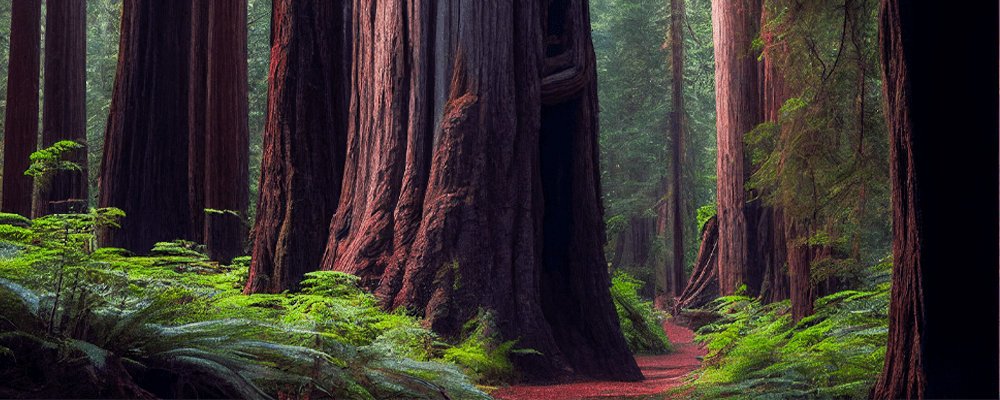Titans of the Forest Empire
Discovery: The first known written record of mammoth redwoods (Sequoiadendron giganteum) in California was in 1833 after a hunting expedition. It was found in the journal of explorer JK Leonard; the reference does not directly mention any locality, but his journey took him through Calaveras Grove. This discovery has not been published. In 1850 John M. Wooster carved his initials in the bark of a tree in Calaveras Grove, but no publication took place.
The first certain and widely documented sighting of mammoth redwoods occurred in the spring of 1852. A hunter, pursuing a bear in the Sierra Nevada, entered what is now known as the "North Grove" in Calaveras State Park. Hunter, Augustus T. Dowd, couldn't believe his own eyes. When he arrived at a nearby mining camp, no one wanted to believe him until they saw for themselves the huge trees that gained instant popularity and became widely known to the public.
The Indians have known these trees for millennia and have held them in high esteem. They even figured out a way to help them reproduce (Sequoias and fire). The native name for these trees was "wah-wo-nah", which was derived from the sounds of owls that often perched in the treetops. The Indian tribes that lived along the Tule River called the tree Toos-pung-ish, Hea-mi-withic .
The sequoia tree, first seen by Augustus T. Dowd, was named the "Tree of Discovery". After many centuries, the tree, which had withstood storms and forest fires, was encountered by western man in 1852, and a year later the tree was cut down...
Sequoia logging
The first attempts at sequoia harvesting were characterised by high time requirements. It took five men almost one month to harvest a 1300-year-old tree. The yield from the giant sequoia was minimal, due to the poor quality of the wood. The tree often broke into pieces when it fell. The loggers tried to avoid this as much as possible by digging deep trenches and filling them with branches to cushion the fall.
The soft and brittle wood was mainly used to make small poles for use in the vineyards and not as building material because it was too soft.
Coast redwoods

Discovery: the Sequoia sempervirens was discovered when California was first settled by Spanish settlers. Since they are native to the West Coast, it was easy to penetrate their forests, which is directly related to the beginning of their clear-cutting.
Gold Rush in the 19th century brought thousands of new settlers who naturally began to consume large quantities of timber. This, of course, had an impact on the way the redwood forests were logged.
The pressure for logging and pillaging increased year by year. This was also due to the fact that redwood wood is a very high quality building material. 
Wood Properties: Redwood lumber is fire resistant and does not need any chemical additives to protect it from fire, rot or pests. The natural tannins that give redwood its characteristic colour also give it a natural resistance to insects, rot and fire. Dimensional stability is a particularly valued characteristic of this timber.
Act for construction: In the state of California, there was a law that allowed the construction of foundations for houses using only redwood lumber. The logging pressure was so high that between 1850-1960, 94% of all native redwood forests were logged.
Sources
Tweed, William C. (2016). King Sequoia: The Tree that Inspired a Nation, Created Our National Park System, and Changed the Way We Think about Nature. Heyday. ISBN-13: 978-1597143516.
- https://www.monumentaltrees.com/en/trees/giantsequoia/history/
